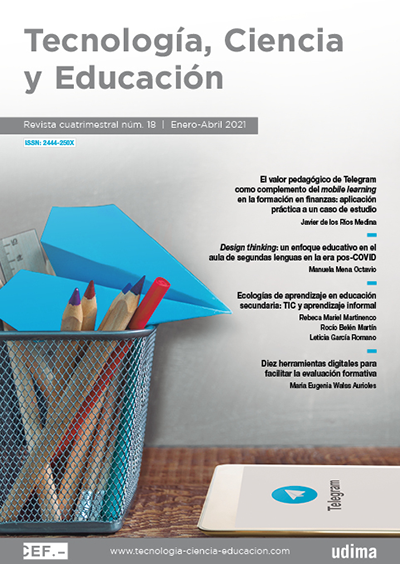The pedagogical value of Telegram as a complement to mobile learning in finance training: practical application to a case study
DOI:
https://doi.org/10.51302/tce.2021.567Keywords:
Telegram, mobile learning, learning models, pedagogical usability, technical usability, technology acceptance model (TAM), video, chatbot, e-learning, teaching innovation, problems based learning (PBL), digital transformation, WhatsApp, WeChat, social transformAbstract
This research investigates the pedagogical value of Telegram as a complement to mobile learning in the context of a personal finance course in which 1,205 students participated.
The theoretical basis is based on the constructs developed in the acceptance theory of technology acceptance model (TAM) and in the 10 Nokelainen criteria in relation to pedagogical usability.
The research question positively relates the use of Telegram to learning models, the work of teachers, the interrelationship of students, the importance of content and the use of devices.
The study´s conclusions are very positive, as Telegram stands out for its high degree of satisfaction in relation to the learning model, with a maximum dropout rate of 2.90 %, it is a magnificent complement to the performance of teachers and increases their potential with the use of audiovisual content and the use of multi-devices interchangeably.
Downloads
References
Aldosemani, T. I. (2019). Microlearning for macro-outcomes: students' perceptions of Telegram as a microlearning tool. En T. Väljataga y M. Laanpere (Eds.), Digital Turn in Schools Research, Policy, Practice (pp. 189-201). Springer.
Alkhezzi, F. y Al-Dousari, W. (2016). The Impact of Mobile Learning on ESP learners’ performance. The Journal of Educators Online (JEO), 13(2), 73-101.
Brooke, J. (1996). SUS: una usabilidad «rápida y sucia». Evaluación de Usabilidad en la Industria , 189.
Davis, F. D. (1985). A Technology Acceptance Model for Empirically Testing New End-User Information Systems: Theory and Results. (Disertación doctoral, Massachusetts Institute of Technology).
Dewey, J. (1963). Liberalism and Social Action. Capricorn Books.
Garrote, A., Dessemontet, R. S. y Opitz, E. M. (2017). Facilitating the social participation of pupils with special educational needs in mainstream schools: a review of school based interventions. Educational Research Review, 20, 12-23.
Harrison, R., Flood, D. y Duce, D. (2013). Usability of mobile applications: literature review and rationale for a new usability model. Journal of Interaction Science, 1(1), 1-43.
Heidari, J., Khodabandeh, F. y Soleimani, H. (2018). A comparative analysis of face to face instruction vs. Telegram mobile instruction in terms of narrative writing. JALT CALL Journal, 14(2), 143-156.
Iksan, Z. H. y Saufian, S. M. (2017). Mobile learning: innovation in teaching and learning using Telegram. International Journal of Pedagogy and Teacher Education, 1(1), 19-26.
Martínez Rolán, L. X., Dafonte Gómez, A. y García Mirón, S. (2017). Usos de las aplicaciones móviles de mensajería en la docencia universitaria: Telegram. VI Congreso Internacional sobre Buenas Prácticas con TIC, 18-20 de octubre de 2017. Málaga, España.
Nielsen, J. y Molich, R. (1990). Heuristic evaluation of user interfaces. Proceedings of the SIGCHI Conference on Human Factors in Computing Systems Empowering People CHI ´90 (pp. 249-256).
Nokelainen, P. (2004). Conceptual definition of the technical and pedagogical usability criteria for digital learning material. Proceedings of ED-MEDIA 2004.
Noor, R. M. y Hussin, N. (1970). First experience in implementing PBL for network design and management course. Journal of Problem-Based Learning, 2(1).
Pratama, H. y Prastyaningrum, I. (2019). Effectiveness of the use of integrated project based learning model, Telegram messenger, and plagiarism checker on learning outcomes. Journal of Physics: Conference Series, 1.171(1), 1-11. https://doi.org/10.1088/1742-6596/1171/1/012033
Salas, M. A. y Subía, J. C. S. (2018). M-Learning-Una experiencia colaborativa usando el software Telegram. Revista Científica Retos de la Ciencia, 2(1), 85-94.
Sari, F. M. (2017). Maximizing Telegram application for teaching reading. 4th UAD TEFL International Conference (pp. 228-233), 9-20 de septiembre. Indonesia.
Shneiderman, B. (1996). The eyes have it: a task by data type taxonomy for information visualizations. Proceedings 1996 IEEE Symposium on Visual Languages (pp. 336-343). Washington DC, EE. UU.
Sivabalan, K. y Ali, Z. (2019). A systematic review on mobile instant messaging as a collaborative tool for language learning. International Journal of Language Education and Applied Linguistics, 9(1), 99-109.
Tullis, T. S. y Stetson, J. N. (2004). A comparison of questionnaires for assessing website usability. Usability Professional Association Conference (pp. 1-12). Mineápolis, EE. UU.
Venkatesh, V. y Davis, F. D. (2000). A theoretical extension of the technology acceptance model: four longitudinal field studies. Management Science, 46(2), 186-204.
Vygotsky, L. (1978). Interaction between learning and development. Readings on the Development of Children, 23(3), 34-41.
Xodabande, I. (2017). The effectiveness of social media network Telegram in teaching English language pronunciation to Iranian EFL learners. Cogent Education, 4(1), 1-16. https://doi.org/10.1080/2331186X.2017.1347081
Downloads
Published
Versions
- 2021-11-22 (3)
- 2021-11-22 (2)
- 2021-01-27 (1)
How to Cite
Issue
Section
License
Copyright (c) 2021 Javier de los Ríos Medina

This work is licensed under a Creative Commons Attribution-NonCommercial-NoDerivatives 4.0 International License.


























